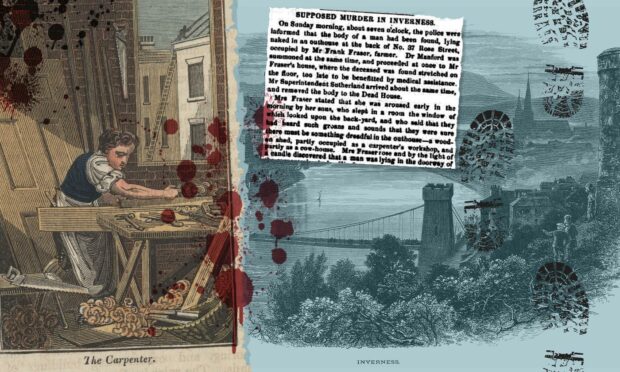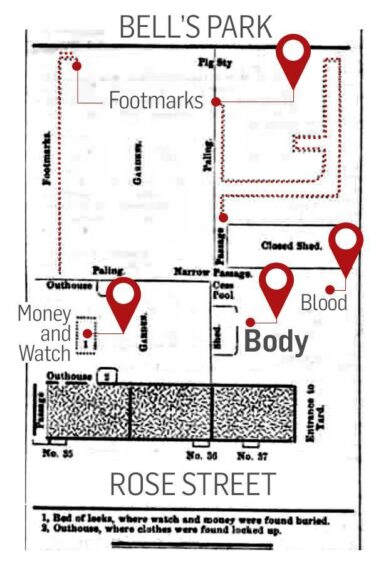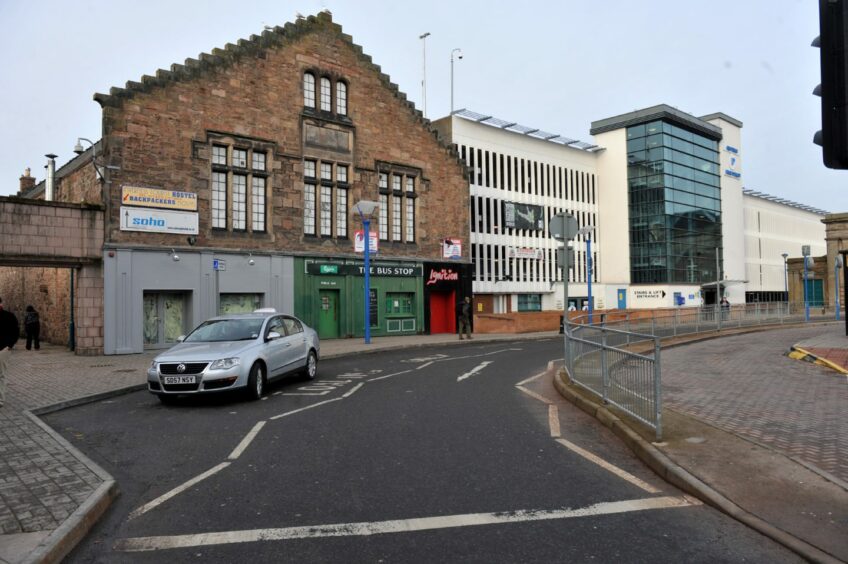The centre of Inverness could be a dangerous place to land up in Victorian times, as one young innocent carpenter was to find out, fatally, in December 1861.
Exactly how 23 year old David Cumming, of Turnbull’s Court, Shore of Inverness, met his end in garden land between Rose Street and Bell’s Park remains a mystery to this day.
But the incident shines a light on the extreme poverty of the age and how hunger and destitution could drive fragile families to commit drastic acts.
It was a Sunday morning, about 7am.
Neighbours in Rose Street had been disturbed through the night, as usual every Saturday, by shouting and yelling from one particularly troublesome family, the Fergusons.
They were a dirt poor family, headed by mason Nicol, who lived with his wife, three daughters and a grandchild in one bare room and a cupboard.
Violence and uproar a regular occurrence
The neighbours were used to hearing violence and uproar from their dwelling, especially on ‘pay nights.’
But this time it was worse, and different from usual.
The Fraser family, farmers, stayed in 37 Rose Street, and the sons of the family slept in a room overlooking the back yard.
They reported they’d heard groans and commotion at night to make them sure there must be ‘something dreadful’ in the outhouse, a wooden shed, part byre, part carpenter’s workshop.
When their mother went to investigate she found David Cumming, lying naked but for his socks and one boot, in the doorway of the shed.
Wound behind the temple
He had a deep cut behind the left temple, and a good deal of blood on his face.
She screamed loudly, and feeling the body still warm, dragged him into her house to try and save his life.
The doctor was summoned, but it was too late.
Shortly afterwards, Superintendent Sutherland arrived, and ‘removed the body to the Dead House’, reported the Inverness Courier.
When police searched the surroundings, they found Cumming’s coat and cap on a nearby dunghill.
By daybreak, they had discovered the rest of his clothes locked in an outhouse at the Ferguson’s home two doors away at no 35.
Apparently they had been found in the garden by the 13 year old Ferguson daughter.
The clothes were then later given to Mrs Fraser by the eldest Ferguson daughter, Mrs Judge, who stayed with her father, and was employed at Holm Mills.
They were handed to the police and found to be ‘saturated with offensive matter, smelling strongly.’
Missing boot found
The missing boot was discovered in the Ferguson’s garden.
In the kailyard in the middle of the ground, Superintendent Sutherland discovered, barely buried, Cumming’s watch, broken watch guard, a neck tie and one shilling three halfpence in cash.
An axe for chopping wood was found, bearing marks of blood.
There was blood and vomit in the garden, and track marks as if someone had tried to drag something along.
The Nicolson family were arrested and jailed, based on the clothes being found in the possession of the eldest daughter, and the hiding of any items of value in the garden plot.
But there were two theories about the events of that night.
Some speculated that that it wasn’t a case of murder, but that Cummings had fallen into the cesspool, lined with ‘sharp mason work’ and took a blow to his temple.
“When he got up he staggered to the corner where the blood and traces of vomiting were found, and stupefied by the fall, and disgusted by the offensive smell of his clothes, threw them off and made for the carpenter’s shed behind Fraser’s house, where he died of exposure and the injury he had received.” (Inverness Courier)
Others weren’t so sure
Amid the noise the previous evening, Mrs Judge had been heard shouting: “What have I done, what have I done”, amid even more uproar and comings and goings than were usual at the residence on a Saturday night.
Cumming’s body showed marks of violence and looked as if it had been dragged through garden soil, rather than having fallen into the cesspool.
The media tried to balance out the speculation: “The incidents of this unhappy affair appear in some respects inconsistent with any theory that has yet been suggested.
“The mystery hanging over the case, the extraordinary circumstances under which the body was found, the apparent absence of any adequate motive for murder have created a greater degree of public curiosity than any case that has occurred in this quarter for many years.”
The case was put into the hands of solicitors Stewart and Rule for investigation with a report to be submitted to Crown Counsel.
Catherine Judge and her parents Nicol and Catherine Ferguson were charged with the crime of murder, and assault to the danger of life, and robbery at Rose Street.
It emerged that David had done a full day’s work in Tomatin that Saturday, and walked to Inverness —17 miles—to pick up his £1 wages from his employer, George Mackay of Margaret Street.
Parents already grieving previous loss
He had planned to spend Sunday at home with his parents, already grieving the loss of another son in a drowning accident.
He had spent 3 shillings on tobacco, 2s 6d on the necktie later found in the Ferguson’s garden and a few shillings treating friends he’d met up with in Inverness.
Unfortunately, he had earlier met Nicol Ferguson’s brother, who was working in Daviot, and had told him to go to Nicol’s, as there was work for him.
Was this a scheme cooked up by the family, knowing that innocent young Cummings would have his wages in his pocket?
In the event, only two shillings were recovered, scarcely worth killing for.
The Fergusons lived in desperate squalor
The press reported that their dwelling was “almost entirely destitute of the commonest articles of furniture and did not contain a single blanket”.
It continued: “There was a chaff bed in the principal room which we are told was usually occupied by Ferguson, and his second and third daughters.
“The closet contained a fixed bedstead, filling with shavings and straw but not a particle of bedclothes.
“This was the ordinary sleeping place of Mrs Ferguson, her daughter Mrs Judge and her grandchild.
“No food in the house on Sunday morning, except about 6d worth of oatmeal.
“No crockery, no eating utensils, nothing in fact but the two bedsteads, a table a chair and one or two trunks.
“A more lamentable scene of squalor, wretchedness and dirt could hardly be conceived.”
The trial of Catherine Judge, Nicol Ferguson and his wife Catherine took place on May 1 1862, in Inverness High Court.
Mrs Judge was found guilty of assault, which she confessed to, and sentenced to 18 months in Perth Prison.
The case against her parents went no further.
You might also like:
Inverness murder trial: Dying woman crawled from gory scene after husband slit her throat
What happened to Penuel Sheriffs? Disappearance of Aboyne mother still a mystery after 63 years
Who killed gentle Buchan postmistress in Black Panther-style robbery 40 years ago?


